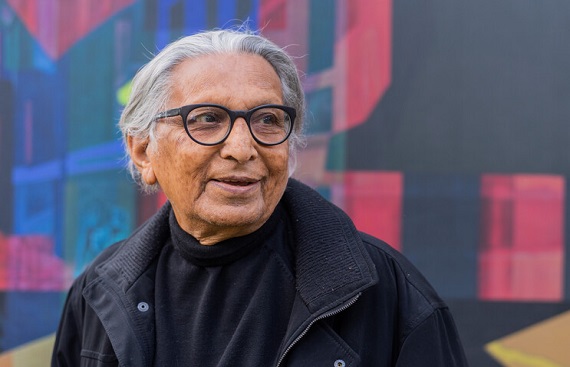Royal Gold Medal Awardee Balkrishna Vithaldas Doshi

Balkrishna Vithaldas Doshi is a prominent figure in Indian architecture and is known for his contributions to the development of architectural discourse in India. At 94, Doshi is the only one from India to have been awarded both the Royal Gold Medal and the Pritzker Architecture Prize, often referred to as the Nobel Prize in architecture.
Doshi had never formally studied architecture. So he learned architecture from his family and two great architects - Le Corbusier and Louis Kahn. Doshi is a pioneer of modernist and brutalist architecture in India. What he has done in his 70-year-old career is make architecture an extraordinary benevolence, not only housing life but skillful enough and clever enough to have an essence for people who continues to adapt and enjoy architecture. He has developed a stance on architecture as a living organism, not a planned object.
Doshi’s Early Life and Career
Doshi was born in Pune and studied at the Sir J. J. School of Art in Mumbai between 1947 and 1950. Doshi was brought up in his grandfather’s house in Pune, and that house grew every time because of his addition to the family. His grandfather owned a furniture workshop, and Doshi initially believed he would take up that profession. However, that growing house impacted him on houses that grow, the staircases that goes across and the mohalla where you meet and talk to people on balconies and the communities.
Doshi went to Europe and worked very closely with Le Corbusier on the latter's projects in Paris between 1951 and 1954. In 1954, he returned to India to manage Corbusier's Ahmedabad buildings, including the Villa Sarabhai, Villa Shodhan, Mill Owners' Association Building, and Sanskar Kendra. Corbusier had created a significant influence on Doshi's later work.
His studio, Vastu-Shilpa, was founded in 1955. Doshi worked closely with Louis Kahn and Anant Raje when Kahn designed the campus of the Indian Institute of Management, Ahmedabad. In 1958 he was a fellow at the Graham Foundation for Advanced Studies in the Fine Arts.
In the recent Media Interaction, Doshi told what motivated him to get into architecture “I would go frequently to pols of Ahmedabad to see how many houses have transformed how many are being changed. That made me to get into architecture, not really as a product but as a process. Normally, we design a building and that building does not change but if you go to old city and other places buildings have changed over time. I am mesmerized by that and that is how I started the School of Architecture in 1962 in Ahmedabad which today is the CEPT University.”
In a career traversing over 100 projects, Doshi has influenced the trend of architecture in India and its neighbouring regions through his practice and teaching. His buildings blend pioneering modernism with vernacular, informed by deep gratitude for the traditions of India’s architecture, climate, local culture, and craft.
Recognition and Awards
Doshi is a Partner of the Royal Institute of British Architects and has been on the selection committee for the Pritzker Prize, the Indira Gandhi National Centre for Arts, and the Aga Khan Award for Architecture. He is also a Partner of the Indian Institute of Architects.
Doshi's work on the reunification of Indian and English heritage through his practice was awarded a Global Award for Sustainable Architecture in 2007, the award's first edition. The award acknowledged Doshi's significant step in the direction of an alternative development model.
In March 2018, Doshi was awarded the Pritzker Architecture Prize, the Nobel equivalent for the field, thus becoming the first Indian to welcome the honor. The Pritzker jury revealed that Doshi "has always created an architecture that is serious, never showy or a follower of trends." It noted his "deep sense of commitment and a desire to contribute to his country and its people through high quality, authentic architecture."
Doshi has earned several international and national awards and honors. In 2020, he was also awarded the Padma Bhushan, the third-highest civilian award in India, for his contribution to the field of architecture. In addition to three Honorary Doctorates from prestigious international universities, including the latest from the Boston Architectural College, the USA, in 2021. He is also the recipient of the French Global Award for Lifetime Achievement for Sustainable Architecture by the InstitutFrancais architecture, Paris.
Royal Gold Medal, Royal Gold Medal for Architecture for the year 2022, Government of United Kingdom, through the RIBA and by personal permission by Her Majesty The Queen – it is the UK's highest architectural honor.
Doshi expressed, “I am deeply humbled to receive the Royal Gold Medal from the Queen of England. The news got back memories of my time working with Le Corbusier in 1953 when he had just received the news of getting the Royal Gold Medal. Six decades later, I feel truly overwhelmed to be presented with the same award as my guru, Le Corbusier — honouring my six decades of practice.”
Read More News :


.jpg)
